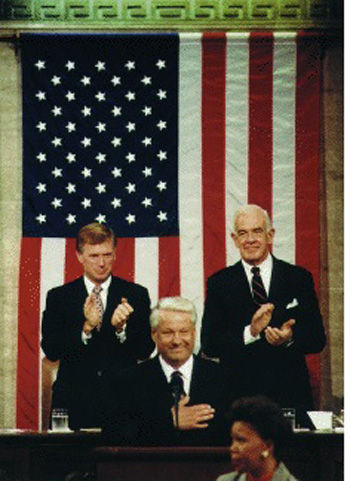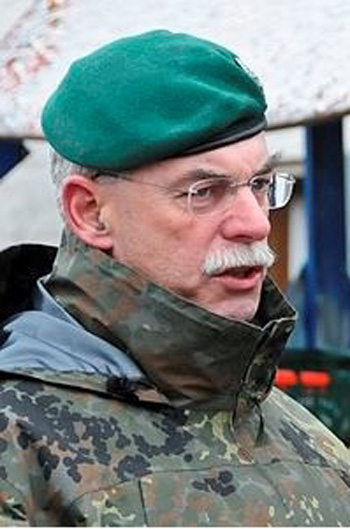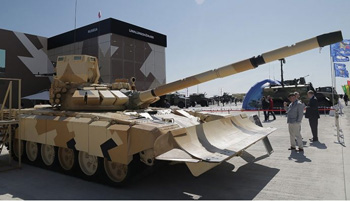International Affairs
 |
 |
 |
 |
 |
 |
 |
The Curse of the Peace Dividend
It wasn't supposed to be like this. On December 25, 1991, the once mighty Union of Soviet Socialist Republics (USSR) evaporated with the resignation of the last Soviet head of State, Mikhail Gorbachev. Around the world, but especially in the United States and Europe, politicians talked of a “peace dividend,” money once expected to be spent on weapons would go to civilian uses. The spending on major weapons systems, from tanks to missile development, plummeted. The president of the newly established Russian Federation, Boris Yeltsin, promised cooperation with the West, the cultivation of democracy and the establishment of free markets in Russia. Unfortunately, the “peace dividend” and everything it depended upon is proving to be illusory, and Europe is again lurching toward continent-wide war.
 The reaction of the Inspector of the (German) Army, Lieutenant General Jörg Vollmer, to the now unavoidable reality of Russian aggression is almost poignant. As the German armed forces struggle to modernize and attempt to deter Russian expansion, Vollmer recently stated that Germany would have to rebuild its military which had been diminished for “understandable reasons.”
The reaction of the Inspector of the (German) Army, Lieutenant General Jörg Vollmer, to the now unavoidable reality of Russian aggression is almost poignant. As the German armed forces struggle to modernize and attempt to deter Russian expansion, Vollmer recently stated that Germany would have to rebuild its military which had been diminished for “understandable reasons.”
The collapse of the Soviet Union and its feared military were most prominent in the list of “understandable reasons” for neglect of the military, not just in Germany and Europe, but also in the United States. Tragic blindness, however, must now, at last, be acknowledged as a primary factor.
The present combination of Moscow's belligerence, deployment of advanced weaponry and the use of innovative military strategies did not happen overnight. It took years of preparation on the part of Moscow and was aided by an uncomprehending West.
In reality, important elements of the Soviet assault on the West never abated, even with the disappearance of the Soviet Union. The continuation of Moscow's espionage offensive against the West in general, and the United States in particular, reached Cold War levels by 2001. Ten years after the so-called “fall of Communism,” the infamous Soviet/Russian spy Robert Hanssen was uncovered, as was the Cuban spy Ana Belen Montes, a senior policy analyst for the Defense Intelligence Agency who helped form U.S. government policy toward Cuba.
 The “new” Russia not only maintained what financial assistance it could to Communist Cuba, including payment of rent for the electronic spy base at Lourdes, but Russian intelligence continued the Soviet practice of working closely with the highly skilled (and Soviet trained) Cuban intelligence services, which were (and are) very active in the United States.
The “new” Russia not only maintained what financial assistance it could to Communist Cuba, including payment of rent for the electronic spy base at Lourdes, but Russian intelligence continued the Soviet practice of working closely with the highly skilled (and Soviet trained) Cuban intelligence services, which were (and are) very active in the United States.
One aspect of “democratic” and “free market” Russia's foreign policy should have been particularly startling to the West: Moscow's embrace of the Peoples Republic of China (PRC).
During the last decades of the Soviet era, the public relationship between Moscow and Beijing deteriorated ostensibly over ideological and national border issues. The world even witnessed a seven-month-long border conflict between the two communist giants in 1969. Interestingly enough, the issue over national boundaries began to be resolved in May 1991, a few months before the Soviet Union evaporated.
The “new” Russia under the “reformer” Boris Yeltsin almost immediately established warm relations with the PRC, sent military equipment to China, trained Chinese military personnel, and, most remarkably, in 1997 declared a “New World Order” with China's then-leader, Jiang Zemin.
The “new” Russia also maintained exceptionally close relations with the Stalinist ruler of the eastern European nation of Belarus, Alexander Lukashenko. The same year Yeltsin declared the “New World Order” with the Peoples Republic of China, the Russian president also declared a “Union State” between the Russian Federation and pro-Soviet Belarus.
Before Yeltsin handed the Russian government to “ex”-KGB officer Vladimir Putin, the signs were all there. Yeltsin and his associates talked about democracy and free markets, but, aside from seeking Western investment and technical assistance, Moscow's actions were diametrically opposed to the ideals or interests of the West. Putin pushed Russian society further toward an outright admiration of all things Soviet. The Russian army began to bear a striking resemblance to the Red Army of the past, Soviet spies of old were publically honored, and Russian warplanes and ships again prowled the world as in Soviet days, including the Caribbean Sea off America's Gulf Coast.
Not until Russia stripped the Crimean Peninsula from Ukraine, however, did the West finally begin to awake. Moscow caught the world by surprise with its adroit use in Crimea of so-called “hybrid warfare,” the insertion of troops without identifying insignia to assist pro-Russian fighters combined with the use of cyber warfare. Russia, then, came to the aid of separatists in Ukraine resulting in the eastern section of the country falling under de facto Russian control.
Moscow, however, is not reliant merely on “hybrid warfare,” as Russia's intensive military buildup and modernization over the last decade proves. Russian ground, air, naval and missile forces are becoming state-of-the-art with well-trained support personnel.
Eastern Europe, once under Soviet rule, is alarmed. NATO is creaking into motion attempting to offer a response, but the “peace dividend” and years of ignoring the obvious have taken their toll.
 As an example, Germany, the lynchpin of NATO's resistance to Russian attack, is woefully unprepared. German Defense Minister Ursula von der Leyden wants to add four thousand troops to the army (known as the Bundeswehr), but recruiting into the all-volunteer force is already lagging behind earlier goals by more than three thousand troops, according to one German online press report. Of the 166,818 troops on paper in the German army, only about 132,000 are actually combat ready.
As an example, Germany, the lynchpin of NATO's resistance to Russian attack, is woefully unprepared. German Defense Minister Ursula von der Leyden wants to add four thousand troops to the army (known as the Bundeswehr), but recruiting into the all-volunteer force is already lagging behind earlier goals by more than three thousand troops, according to one German online press report. Of the 166,818 troops on paper in the German army, only about 132,000 are actually combat ready.
Moscow has modernized its venerable T-72 tank for specialized use in urban warfare. One can only hope and pray, that Germany, the other members of NATO, and especially the United States, present a powerful and unified counter to Russian aggressiveness before T-72 tanks start to roll into various European – or U.S. – cities

Toby Westerman publishes
International News Analysis - Today
An uncompromising weekly analysis of the world situation
Contact T. Westerman at
www.inatoday.com
or P.O. BOX 5182, Rockford, ILL, 61125-0182

Boris Yeltsin at the U.S. Congress
The collapse of the Soviet Union and its feared military were most prominent in the list of “understandable reasons” for neglect of the military, not just in Germany and Europe, but also in the United States. Tragic blindness, however, must now, at last, be acknowledged as a primary factor.
The present combination of Moscow's belligerence, deployment of advanced weaponry and the use of innovative military strategies did not happen overnight. It took years of preparation on the part of Moscow and was aided by an uncomprehending West.
In reality, important elements of the Soviet assault on the West never abated, even with the disappearance of the Soviet Union. The continuation of Moscow's espionage offensive against the West in general, and the United States in particular, reached Cold War levels by 2001. Ten years after the so-called “fall of Communism,” the infamous Soviet/Russian spy Robert Hanssen was uncovered, as was the Cuban spy Ana Belen Montes, a senior policy analyst for the Defense Intelligence Agency who helped form U.S. government policy toward Cuba.

General Vollmer: Germany has to rebuild its military
One aspect of “democratic” and “free market” Russia's foreign policy should have been particularly startling to the West: Moscow's embrace of the Peoples Republic of China (PRC).
During the last decades of the Soviet era, the public relationship between Moscow and Beijing deteriorated ostensibly over ideological and national border issues. The world even witnessed a seven-month-long border conflict between the two communist giants in 1969. Interestingly enough, the issue over national boundaries began to be resolved in May 1991, a few months before the Soviet Union evaporated.
The “new” Russia under the “reformer” Boris Yeltsin almost immediately established warm relations with the PRC, sent military equipment to China, trained Chinese military personnel, and, most remarkably, in 1997 declared a “New World Order” with China's then-leader, Jiang Zemin.
The “new” Russia also maintained exceptionally close relations with the Stalinist ruler of the eastern European nation of Belarus, Alexander Lukashenko. The same year Yeltsin declared the “New World Order” with the Peoples Republic of China, the Russian president also declared a “Union State” between the Russian Federation and pro-Soviet Belarus.
Before Yeltsin handed the Russian government to “ex”-KGB officer Vladimir Putin, the signs were all there. Yeltsin and his associates talked about democracy and free markets, but, aside from seeking Western investment and technical assistance, Moscow's actions were diametrically opposed to the ideals or interests of the West. Putin pushed Russian society further toward an outright admiration of all things Soviet. The Russian army began to bear a striking resemblance to the Red Army of the past, Soviet spies of old were publically honored, and Russian warplanes and ships again prowled the world as in Soviet days, including the Caribbean Sea off America's Gulf Coast.
Not until Russia stripped the Crimean Peninsula from Ukraine, however, did the West finally begin to awake. Moscow caught the world by surprise with its adroit use in Crimea of so-called “hybrid warfare,” the insertion of troops without identifying insignia to assist pro-Russian fighters combined with the use of cyber warfare. Russia, then, came to the aid of separatists in Ukraine resulting in the eastern section of the country falling under de facto Russian control.
Moscow, however, is not reliant merely on “hybrid warfare,” as Russia's intensive military buildup and modernization over the last decade proves. Russian ground, air, naval and missile forces are becoming state-of-the-art with well-trained support personnel.
Eastern Europe, once under Soviet rule, is alarmed. NATO is creaking into motion attempting to offer a response, but the “peace dividend” and years of ignoring the obvious have taken their toll.

Russia has modernized its tank for urban warfare
Moscow has modernized its venerable T-72 tank for specialized use in urban warfare. One can only hope and pray, that Germany, the other members of NATO, and especially the United States, present a powerful and unified counter to Russian aggressiveness before T-72 tanks start to roll into various European – or U.S. – cities

Posted June 27, 2016
International News Analysis - Today
An uncompromising weekly analysis of the world situation
Contact T. Westerman at
www.inatoday.com
or P.O. BOX 5182, Rockford, ILL, 61125-0182
______________________
______________________
 Volume I |
 Volume II |
 Volume III |
 Volume IV |
 Volume V |
 Volume VI |
 Volume VII |
 Volume VIII |
 Volume IX |
 Volume XI |
 Special Edition |
 Special Edition |


